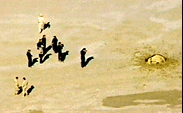

You’ve undoubtedly seen Comic Sans, the Microsoft font that attempts to look like classic comic-balloon writing. It doesn’t, of course: Quite the contrary, it is a “painful and inadequate usurpation of comicbook style lettering”, as blogger Brandon Rickman correctly puts it. But because Comic Sans looks “wacky” and “goofy”, it is constantly used in Powerpoint presentations, as the assistant vice president in charge of paperclips attempts to kickstart his two-stroke-engine of a soul and somehow express his inner creativity.
Clearly, this madness must stop. So it came as no surprise for me to discover that there is a highly-organized campaign to ban Comic Sans. As their web site argues, Comic Sans …
… has been used in countless contexts from restaurant signage to college exams to medical information. These widespread abuses of printed type threaten to erode the very foundations upon which centuries of typographic history are built.
There is no way for reasonable adults to disagree.
As a public service, the site hosts free-for-download fonts that do a much better job of emulating comic-book lettering; one of my favorites is “Action Man”!
(Thanks to Brandon for this one!)

Sir Richard Branson has just announced that he is licensing Burt Rutan’s SpaceShipOne technology so that by 2010, he can launch a commercial space-tourism airline. The title? Virgin Galactic. He’s already got a web site up for it, and even a corporate logo. And you gotta know that the designer who created that logo had the single best day of his or her entire career. “Hey, listen, we’re launching a spaceship airline. Can you make us a logo by 4 o’clock?” According to the New York Times, the flights will cost $190,000 (including training), will last three hours, and will include four minutes of weightlessness, as well as a cocktail.
Check out the site for more details, including the florid Carl-Sagan-remix-a-go-go prose:
As you hurtle through the edges of the atmosphere, through the panoramic individual windows you will be able to see the cobalt blue sky turn to mauve and indigo and finally black. Out will come the stars, clear and bright… even though it is daytime! [snip]
The ship will manoeuvre, so you can look for the first time back at the planet you have just come from. The view will be over a thousand miles in any direction. That’s like seeing North Africa if you were in a spaceship above London or Miami from overhead Washington DC. You will see the clarity of the solar system and the harshness of the sun.
It will be humbling. It will be spiritual.
Billions and billions of stars. Beelions and beelions.
As astute readers of my previous giant-squid posts will know, scientists have never observed one of these monsters alive. We only find them when they wash up dead on shores. In Spain, they normally only find one giant squid per year. But in the autumn of 2001, five suddenly washed up dead, and in 2003 another four were discovered. What happened to kill them all at once?
A marine expert in Spain thinks he knows the culprit: Oil companies. Angel Guerra of the Institute for Marine Investigations noticed that in those precise time periods, offshore oil companies were firing high-intensity sonar at the sea floor to try and find new oil reserves. Those sonar guns shoot utterly ferocious noise: 200-decibel pulses of 100-hertz sound, from an array of 10 guns. When scientists examined the dead giant squid, they found that none had external damage — so it was unlikely they’d been killed by another sea creature. But they did have extensive internal injuries, as the New Scientist reports:
In two squid the damage was extensive, with stomachs and hearts ripped open and muscles disintegrated. “Some organs were unrecognisable,” says Guerra.
And all the squid had badly damaged ears. Guerra thinks this might have disoriented the giant animals and made them swim to the surface, where they suffocated, as water temperatures there are too warm for the oxygen-carrying molecules in their blood to function. He suspects that in squid with massive internal damage, the blast caused dissolved gases in their tissues to form bubbles, such as those produced by shaking a fizzy drink.

More proof that the trend towards political video games is accelerating: The Republican party of Illinois has just released the Take Back Illinois online video game, designed by the brilliant dudes over at Persuasive Games. It’s intended to highlight the positions of the state’s GOP in several key issues, including medical malpratice reform, education, participation, and economic reform. Each area is represented by a little minigame, and the first one out is “medical malpractice”.
My verdict? It’s incredibly cool, and possibly one of the best political games I’ve ever seen. That’s because political games are usually caught in a design dilemma: If you foreground the game’s “message”, it’s usually at the expense of gameplay — the game is boring. But if you focus on merely creating killer gameplay, then the play takes over and the sense of “message” can be lost. The best games are thus ones that try to illustrate a dynamic process, because dynamic processes are sort of game-like to begin with. That’s why economics and law can, oddly, be a lot of fun to study. You think of a bunch of rules, set them in motion, and see what happens; then you tinker with the rules and see what happens again. It’s just like any of Will Wright’s good Sim games.
In the medical malpractice game, the concept is deceptively simple. You’re looking down on a city in “god” mode, and your citizens are either healthy, slightly ill, or critically ill. You have to try to quickly locate the critically ill ones and get them to a hospital before they die. But the hospitals have their own budgetary restraints, and can only handle so many patients; shove a couple of sick people into one hospital and it’ll be “full” until they heal. Thus, you quickly wind up in a frantic juggling game, when you realized that the hospital nearest to a sick person is full and you have to route them all the way across town, praying they don’t die before they get there … kind of like real life, right? The political content arrives in your ability to increase or decrease the maximum malpractice awards that people get for suing hospitals. Decrease it, and, according to Republican logic, the hospitals save money and presto! They can handle more patients, and the game becomes easier. Similarly, you can increase the research support for medical safety and training, and that makes the game easier too. By letting you twiddle with a couple of simple policies, the game lets you “see” precisely what the Republicans would like to do to Illinois — and the good things they hope would come of it.
One could, of course, argue with the logic of the game. Democrats would say that a far better way to decrease hospitals’ costs would be not to limit malpractice — which they’d argue is an issue of justice — but to rein in the enormous profits of pharmaceuticals, thus bringing down the cost of drugs. But whether or not one agrees with what the Republicans are trying to teach with this game, the point is, the way that it teaches is wonderfully elegant.
If anything, it’s almost too much fun: The play value of the game almost overrides the message. For example, I discovered that while I could get a higher score by following Republican policies (and helping the hospitals improve their care), I found it more enjoyable to let the health-care system degrade into chaos. It’s more exciting that way! I got more nail-biting thrills out of having the hospitals quickly fill up and turn patients away, forcing me to desperately route the nearly-dead patients somewhere else. It’s just like any video game that has settings for “easy”, “normal”, and “hard”. The “hard” setting is brutal — you get killed and killed and killed again — but it’s also just maniacally fun, as virtual chaos and mayhem are wont to be. Still, all in all, this is one of the best political games I’ve yet played.

Back when he was writing the Principia Mathematica, Isaac Newton argued with his pal Chistiaan Hyugens about an interesting question: Would someone swim faster through water or through a thick, viscous goo? Newton bet you’d go slower; Hyugens argued the opposite. Newton decided to put both viewpoints in the Principia, since he couldn’t resolve it. There seemed to be no way to test it: Who was going to go to the trouble of constructing a massive tank and filling it with goo?
A professor at the University of Minnesota, as it turns out. Edward Cussler took 300 kilograms of guar gum, a thickening agent found in salad dressing, and dumped it into a 25-meter swimming pool on campus. The result was a goo twice as thick as water. He then — and I cannot imagine what these conversations would have been like — convinced 16 volunteers to jump in a swim a few laps.
“The fluid,” as Cussler told Nature.com, “looked like snot. I don’t know how to describe it any more poetically.”
The result? Turns out Hyugens was right: The swimmers didn’t go any faster in water than in the goo. Cussler says that’s because that while the goo generates more drag on your body, it also lets you generate more force with each push and kick. However, as you’d expect …
… the most troublesome part of the experiment was getting permission to do it in the first place. Cussler and Gettelfinger had to obtain 22 separate kinds of approval, including persuading the local authorities that it was okay to put their syrup down the drain afterwards.
But it was worth the hassle, Cussler says, not least because his quest for an answer made him something of a celebrity on campus. “The whole university was arguing about it,” he recalls. “It was absolutely hilarious.”
(Thanks to Stephen for this one!)
In July, I blogged about “emotive” car technology and talked about an innovation I’d always wanted to see: Brake lights that grow brighter depending on how hard, and how suddenly, you’re hitting the brakes. Simple, elegant way to help other drivers keep from colliding, right? Well, apparently BMW has been introducing this innovation to its new cars, as the BBC reports:
Oh, here’s a gimmick for ya: two stage brake light clusters, as already seen on some current BMW models. They inform the following driver whether to brake normally, or whether he’s got two seconds to avoid ploughing into the back of the 1-Series he’s been sitting on the back bumper of to get a closer look. Seems like the men from Munich have thought of everything.
(Thanks to Debbie for this one!)

This is flat-out awesome: Some German geeks have created a playable version of Pong that is driven not by microchips but by old-school physical relays. Instead of silent silicon transistors mysteriously flipping bits back and forth, this game presents you with the fully sensual click and clatter of magnetic relays turning on and off — flipping bits in the most primordial fashion possible. As they put it on their web site:
Pongmechanik is an electromechanical conversion of the classical game Pong. And instead of more realistic graphics, it ever accurately to reproduces the original Pong. The user is hardly changed. However the game breaks open the Black box: What takes place in the computer, becomes again perceptible and comprehensible.
This, to me, is a really important art project. Today’s computer users (and even many programmers) have no serious idea of how computer logic works: Unless you actually look at their schematics, computer chips are silent and utterly mysterious, as physically inscrutable as the monolith in 2001: A Space Odyssey. But computer logic is not at all hard to understand when you replicate it using physical relays — which one can visually see turning on and off. Back in grade seven in 1980, I found a book in my library showing how to build logic gates out of magnetic relays. I went to Radio Shack, bought about 20 relays, and spent the next few months building increasingly complex logical operations, including little adders that could calculate the sums of binary numbers. My parents thought I’d gone insane.
My favorite moment was when I built a flip-flop gate — the basis of computer RAM. It’s just a simple feedback operation: You click a switch that activates a set of relays that begin feeding electricity back to themselves, so they remain eternally on. (They’ll only turn off if you run out of electricity or if you purposely “erase” the memory by actively breaking the circuit.) I built a flip-flop circuit, flipped the switch, watched the relay click on and remain on. It was a trippy, Frankensteinan moment. I’d created a piece of memory — a device that seemed to display some tiny piece of self-consciousness. Very heady stuff when you’re 10 years old!
At any rate, when I started using computers a few years later, I had a reverse-Matrix experience with them: When I ran a program I could imagine it as this enormous football field of electromagnetic relays clacking on and off, the logic muttering to itself like a chorus of crickets at night. It demystified computers a bit, and I think that’s important, because the less you believe that computers are boxes filled with magic elves, the less you’re likely to believe the snake-oil crap that hardware and software companies feed you.
God damn I want one of these mechanical-Pong cabinets. I wonder how much it would cost to have them build one for me? Check out pictures of the device here, and video of it in action here.
It occurs to me that the flip-flop gate takes on an unintentionally lovely resonance in our current political context. President Bush likes to attack John Kerry for being a “flip-flopper” — for changing his mind — arguing that to do so is a sign of weakness and indecision. In a computer context, the metaphor is precisely reversed: Without the ability to change its state, a bit means nothing; without flip-flopping, a computer can neither remember anything nor accomplish anything.
(Thanks to Slashdot for this one!)

The Gravity is a lamp that stands upright when you’re in the room, but slumps down to the ground when you leave. Now, of course, like any geek, I’m all in favor of mucking with technology to foreground its latent animism and reify the psychologically daemonic subtext of modern digital life … but still, this is pretty wack. The Funfurde blog puts it nicely:
The Gravity is equal parts cute and creepy. Cute because it’s sort of like a pet that’s happy to see you when you come home. Creepy because it’s a lamp that moves by itself!

Since the Star Wars DVD came out this week, the Associated Press interviewed Carrie Fisher and Mark Hamill to get some inside dirt on what it was like being sci-fi stars. Fisher is hilarious and completely off the hook; of the Star Wars veterans, she’s cleary the one with the weirdest sense of humor. At one point she talks the Star Wars figurines that began coming out:
Fisher said she liked being a doll, but found some of the Princess Leia merchandise slightly unnerving. “I always liked the shampoo bottle where you twist my head off and pour liquid out of my neck. That’s very Freudian,” she said. “If I dreamed that, what would you think it meant?”
The Globe and Mail just changed its web site so that you can’t read stories without registering; in fact, you can’t read their columnists at all unless you become a paid subscriber. Many newspapers are going this route, citing the obvious reason: They’re losing money because web surfers don’t buy a print copy. (That isn’t a chimerical concern; I have many friends who do precisely this.) There’s also the distinct possibility of the newspaper making a bit of coin off selling the email lists to online marketers, who apparently will pay rather insane rates — up to $300 per thousand — for addresses. Being a guy who occasionally writes for newspapers, and who reads them voraciously and wants them to survive, I’m in favor of anything they need to do to make ends meet.
But … I can’t help but agree with the many bloggers who’ve pointed out a problem: Newspapers that demand registration are not well-crawled by search engines, and thus vanish from view. “If you’re not in Google, you don’t exist,” as the joke goes, and it’s hardly even a joke anymore. One of the prime reasons I started Collision Detection was to build up some Google juice and make it easier for people to find Clive Thompson online. That’s why I dump copies of all my stories into this blog after they’ve been published: I want to make sure my writing doesn’t vanish from sight, and the best way to do that is make damn sure Google and Teoma and Altavista are crawling all over it.
It’s also a matter of global culture. One of the best things about newspapers putting their work online is that it lets foreigners get alternate views of the world. I’ll sometimes learn more about American politics by reading Canadian and European newspapers than by reading US ones. After all, it took a guy from France — Alexis de Tocqueville — to codify and describe the essential genius of democracy; an outsider’s perspective can sometimes be the best way to see what’s going on. If I were one of the columnists at the Globe and Mail, I’d be worried about how the paper is dooming me to global irrelevance.
Though of course, I’d also be worried if my newspaper were being driven out of business by the web. I don’t really know what the answer is here. But I seriously doubt that the way forward for serious print journalism is to avoid the Web.

Wristwatches are the most precise way to tell time, but they’re not the only way. Indeed, we frequently judge the passage of time by a bunch of imprecise, ambient cues in our environment: The pace of our breathing, the changing noises of the street, how long it takes a cup of coffee to cool. That’s why we can often be quite good at knowing “how much time has passed” even when we’re not near a clock.
Conversely, this is why torturers — and many prisons — put their captives in rooms (or hooded cowls) that seal them off from any of the environmental markers of time. It drives them crazy: Without any external markers of the passage of time, the world takes on a troubling sense of unreality. Hell, that’s why cubicle-farms in many corporations are so maddening. When you’re shoved into one of those anonymously beige bins, so deep inside the building that you can’t see out a window, you live in a completely inert environment. No wonder time seems to stand still! Hence the obsession of salarymen and GenX wage slaves — so regularly reflected in comic strips and movies — of glancing up at the clock every five minutes. They’re not doing it merely because they want to leave work. They’re seeking reassurance that the entire universe hasn’t ground to a halt.
Which brings me to the brilliance of the SineClock — a timepiece that exists purely in this ambient space. It has no precision; you cannot look at it to say, “hey, it’s 3:12!” But it nonetheless marks the passage of time in a weirdly soothing way. You download it onto your desktop, and it produces three Moog-like pulsing hums that change subtly as the day goes by. As the creator explains it:
The low pulsing goes from slow to fast to slow over the course of one minute, the medium pulsing goes from slow to fast to slow over the course of one hour, and the high pulsing goes from slow to fast to slow over the course of one day, so if you sit and listen to the low sound for a minute, you’ll hear its pulse slowly speed up for thirty seconds, then slow down for another thirty seconds. Then it starts again.
Because the speed of each pulse is constantly changing, each moment in the day has a distinct set of pulse speeds.
I tried it out, and it’s quite cool: It’s like an electronic version of a babbling brook.
(Thanks to Sensory Impact for this one!)
Yet another patch of work intrudes. Do not adjust your blog. We will shortly return you to your regularly scheduled programming.
I was just working away on some assignments when a random IM popped up on my screen. This the transcript of the entire, short, exchange:
DanRather1CBS: This has been a long week for me.
pomeranian99: I’ll bet.
DanRather1CBS: I was told those memos were legit. We were very thorough.
pomeranian99: Seriously, dude.
DanRather1CBS: These blogs are a pain in the neck. We didn’t have those during the ‘68 convention, I’ll tell you that.
pomeranian99: We aim to please!
DanRather1CBS: Well, I’ve got to get back to work—try to solve this mess. Don’t count me out—this isn’t the first time I’ve been to the rodeo!
pomeranian99: Absolutely. Keep on rocking in the free world.
DanRather1CBS: Thank you, Clive. I appreciate your support. Bye and good luck.
pomeranian99: Horns are up!
Heh. You know, if for some crazy reason that actually were Dan Rather, I can’t imagine what he now thinks of me.

This is quite lovely: Ecotonoha, a project by NEC that allows you to contribute word “leaves” to a virtual tree. Each day, the tree starts bare — and visitors show up to place a word on the branches. You’re only allowed to contribute one word per day, and many visitors accidentally submit the sample text that the Ecotonoha engine begins with (“Hello Ecotonoha!”), which slightly spoils the effect. But when you first load the page, it’ll show you a replay of the entire day, with each person’s cursor zipping up to their area and inserting their word; you watch the tree slowly sprout words. Some of the entries — “Damn customers!” — are pretty hilarious.
Design-wise, though, it’s the ethereal music that gives this app its truly zen-like effect. Indeed, it reminds me of some of the best atmospheric music in really good video games.
(Thanks to Grand Text Auto for this one!)

With their aloof, quiet remove and weirdly meditative ways, cats have always seemed like the mathematicians of the animal world. In his excellent portrait of hacker psychology, Eric Raymond pointed out that hackers are far more likely to have cats than dogs, and adds that “it is widely grokked that cats have the hacker nature”. Maybe this is why I was so tickled to stumble upon The Infinite Cat Project.
It began simply enough. Someone on an Apple forum posted a picture of their cat looking at a flower. Then someone else posted a picture of their cat looking at the picture of the first cat, on a computer monitor. Then someone else posted a picture of their cat looking at that picture — i.e. a cat looking at a cat looking at a cat. And then … well, you can see where this is headed. The Project just reached its 300th cat.
I love the idea that if the pictures could have infinitely high resolution, we could peer deep into the 300th one and see the ur-cat at the center, inspecting the flower, blissfully unaware of the expanding universe it set in motion.
Man, deep space is weird. Remember the Pioneer 10 and 11 probes? They were sent off over 30 years ago, and now they’re well on their way out of the solar system. There’s just one problem: They seem to be in the grip of a mysterious force that’s holding them back. As The Guardian notes, a couple of researchers have found some unexplainable data:
By the time the two spaceships had swept beyond Pluto, they noted there were persistent anomalies in their trajectories. Every time they looked the Pioneers were in the wrong place. The effect was not large, but it was significant. Something more than the Sun’s gravity appeared to have a grip on the craft.
So now the hunt is on for a theory that can explain it. Inaccuracies in our understanding of gravity? Dark matter? Tractor beams from massive alien ships? Okay, that last one’s not really on the table, but many astronomers are now arguing that the only way to figure this out is to send out some more probes to the deepest parts of space, with instruments of higher accuracy. Of course, that’ll take another 30 years, which means I can look forward to perusing the new data from the rocking chair in my home for the elderly. I can’t wait.
(Thanks to Slashdot for this one!)

Wagner James Au is an “embedded journalist” inside Second Life, an online multiplayer game where users can build their own houses and fill them with objects of their own design. He’s been blogging about it for over a year now, profiling scores of people who’ve built gorgeous, intricate, or bizarre environments. At one point, he even happened upon a woman who was homeless in the real world but had a massive compound in the the virtual one.
This week he reports on a new find: A house that has been designed to represent the internal state of a person with schizophrenia. It was created by a university mental-health researcher, and is based on descriptions of hallucinations taken from interviews with real-life schizophrenia patients. The idea, of course, is to do something that only a virtual-reality game can do — which is to allow outsiders to experience, first-hand, the terrifying weirdness of a schizophrenic episode. Au toured and it wrote an excellent description:
Things change, as you approach them, but the shift is subtle. A poster suddenly shifts to contain obscenities; a single word in a newspaper headline suddenly becomes the only word you see. A bookshelf seems to contain nothing but volumes about fascism. And most disturbing to me, a bathroom mirror which contains your reflection becomes, when you come closer, a bloody death mask. The man in the mirror is actually a model, but the hallucination is based on the testimony of a schizophrenic who stopped shaving, because when he looked in the mirror, he’d see his corpse staring back at him. (And when you get close enough to the sink, you hear the strains of bagpipes— because this is the music the man heard too, when he glimpsed his own death.) [snip]
Other shifts are less subtle. The floor falls away into sky, when you start to walk on it. A gun suddenly appears on a table, and a spotlight is cast on it, while a voice keeps commanding you to pick it up, and kill yourself. (This is based on the testimony of a schizophrenic who was arrested after he tried to snatch the pistol from a police officer’s holster.) A stereo broadcasts a radio news program — which, if you listen to it for more than a few seconds, begins speaking to you.
It’s another great example of how useful off-the-shelf video games are becoming at simulating real-life problems. The doctors previously had spent months trying to build a schizophrenia sim from scratch, using a Silicon Graphics workstation, and it didn’t look as good as what they were able to do inside Second Life in only three weeks — since the game was designed to allow its “citizens” to quickly create their own stuff.
A few weeks ago, a friend of mine from Toronto visited me and noticing something that, to him, was weird: Many New Yorkers have never visited the Ground Zero site — and they don’t want to. He asked me to write a piece explaining why, and it was published yesterday. It’s online here, but it goes off the free archive in a week, so here’s a permanent copy:
Ground Zero is for tourists
by Clive ThompsonNEW YORK — A FEW WEEKS AGO, some family members visited me in New York, where I’ve lived for the last six years. They took in the usual attractions and then decided they wanted to check out Ground Zero, the site where the World Trade Center towers were destroyed on 9/11. “I’ve always wanted to see it,” one relative said. “I’ve wondered what it’s like.”
Most tourists feel the same way. Each day, hundreds of visitors flock to Ground Zero, to look at that enormous hole in the ground and the long list of names of the dead. They come to pay their respects, and to try and grasp the enormity of the attack. If you walked down there today, you’d find people from all over the world.
But one thing you won’t find: New Yorkers.
Though most out-of-towners don’t realize it, New Yorkers don’t visit Ground Zero very often. On the contrary, many have avoided going near the site — and they have dim opinions of the crowds that congregate there. I didn’t notice this until a Toronto friend asked me when I’d last visited Ground Zero, and I realized that I’d never once purposely gone to look at it. It wasn’t until this summer that I ran into the site, accidentally, while shopping nearby.
So what’s going on? The world is filing by to mourn. We’re shrugging and turning away. And therein lies an interesting tale about what it means to live next to the most potent symbol of America’s new wars.

Slate has just published my latest video-game column, and this one’s about a favorite topic of mine: Game guides, those step-by-step walkthroughs that help you navigate a complex virtual world. Many people consider these things to be cheating, but I argue they have an oddly literary style and purpose:
Game guides are, in essence, travel literature. Much as a Fodor’s guide makes sure you don’t overlook a key building in Prague, the Doom 3 walk-through tells you to be sure to look behind the mangled steel doors to find a hidden pack of shotgun shells. Game guides aren’t merely utilitarian, though — the best ones point out intriguing bits of architecture and design that might be overlooked otherwise. The Ghosthunter guide suggests that you should enter a house and look down a dark well, lest you miss the giant dead fetus. (“Creepy,” the author shudders). [snip]
It’s hard not to love the incredibly strange prose style. The text has to be surgically precise, like a dry, technical manual for an airplane engine. Yet it’s also describing deeply weird fantasy environments filled with dripping goo and gibbering monsters. The end result is a kind of how-to guide for the damned, replete with unintentionally hilarious one-liners. The Doom 3 guide, for one, notes that “Your one advantage in Hell is that your stamina is unlimited. …” Noted!
You can check out the rest of it here for free, and if you have any thoughts, feel free to post ‘em in The Fray, Slate’s discussion area!

News flash: Atari has signed a deal to produce casino slot-machines based on their classic games — including Pong, Centipede, and Asteroids. As Wim Stocks, their head of sales and marketing, said in a press release:
“There is a huge population that grew up with these Atari games and that audience is still clamoring for ways to recapture the fun of their first gaming experience.”
Heh. Since my earliest gaming experiences consisted of sitting in a dendritical haze while I mechanically shoved an endless stream of coins into glowing machines … why, yes, an Atari-themed slot machine would kinda recapture that thrill, wouldn’t it?
(Thanks to Sean for this one!)

Roboticists these days are getting really good at producing tiny, autonomous ‘bots that can wander around for months — monitoring environments, sensing environmental change, or even doing spy work. We’ve got excellent A.I. for guiding the ‘bots, and cheap parts to make them with. The one problem left? Energy. It’s hard to build a battery that will power a mobile object for months, and harvesting solar energy is too inefficient and unreliable for ‘bot that will be trudging along through the mud. This is why live creatures are so wonderfully robust: We eat food and convert it into energy in a terrifically efficient manner. Isn’t there some way to get robots to do that?
Well — yes there is. A bunch of British scientists have been developing “Ecobot II”, a 22-cm robot that contains eight “microbial food cells” that convert sucrose to energy (PDF about it here). And where do you find sucrose when your ‘bot is wandering through, oh, the Arizona desert, or maybe the ruins of Sarajevo? What does a robot eat?
Flies. Ew. Yes. According to MSNBC, the scientists plan to make the robot stink like rotting flesh so that it attracts flies, kills them, and messily devours ‘em. As one of the scientists noted:
“One of the great things about flies is that you can get them to come to you,” he said.
Of course, you can see where this is headed: Legions of enormous battlebots that gain self-awareness and begin ripping off our arms to feed their insatiable apetite for energy. Christ almighty. When the hell did The Matrix become a reliable predictor of our future?
(Thanks to Rick for this one!)

By now, you’ve probably heard the sad news in science: The Genesis probe crashed yesterday. The probe contains samples from solar winds, and the capsule was supposed to have popped out a parachute to slow it down enough that a couple of helicopters could catch it. Instead, it hit the earth at 311 km an hour and buried itself halfway into the ground. Obviously, losing so much good data sucks for scientists, and I’m depressed myself.
Yet as I looked at the pictures of the fallen capsule, I couldn’t help but notice: Don’t they look, rather hilariously, like secret snapshots of a crashed UFO? All those puny humans, huddled uncertainly around the wreckage of superior extraterrestrial technology! It reminds me of what it’d be like if one of our probes ever landed on a planet with sentient life. What in hell would they think of the metal gizmo we’d plunked down on their back yards? Of course, crashes like this also serve to highlight the Andromeda Strain-class importance of our planetary protection protocols, an issue I wrote about several months ago.
NASA has posted a mesmerizing video of the falling capsule online. It looks even more like some crazy samizdat VHS tape of a plummeting alien mission gone terribly awry.
Still, I gotta hand it to NASA: They’re scientists, so when something goes wrong, they don’t try to cover it up. They show you the pictures, they write the press releases glumly concluding that everything went all to hell. It’s another reason I so prefer the culture of science to that of our sneeringly mendacious government administration. If anything goes wrong with the nation, you can count on Bush’s minions to try and hide it. But when something goes wrong in science, researchers immediately trot out the painful evidence. “Sure. Check it out. Here’s a video of our $260-million probe slamming into the earth like a bag of anvils tossed out of heaven.”
Here’s an interesting high-tech milestone: In a story on Shamil Basayev — the warlord who masterminded the horrid Russian slaughter — CNN cites a Wikipedia entry:
During the rebel pullout from Grozny in January 2000 Basayev lost a foot after stepping on a landmine, according to the Wikipedia Web site, but he and other rebel fighters eluded Russian capture by hiding in forests and mountains.
Last month I wrote a piece for Slate about whether mobs of people could produce art — and cited Wikipedia as the leading example of a creative work. I frequently use Wikipedia myself, but I’m fascinated to see that CNN now regards it as an authority.
(Thanks to Boing Boing for this one!)

Have I got your attention now? The Eyetrack III project took a bunch of San Franciscans, plunked them down in front of various news web-sites, and tracked their eye movement — to find out what, precisely, we look at. That chart above tracks the most common results: People start in the upper left quadrant of the screen, zip to the right, then zigzag down before landing in the upper right corner.
Of course, what I immediately began wondering is — how does Collision Detection stack up? I’m no web designer; two years ago, I spent a weekend leafing through free templates at Blogskins and swiped my current look, which was created by Tyler Cole and is called “Carabeth Blue”. I liked it because it was simple, but as it turns out, it nicely cleaves to the standard viewing pattern of web surfers! After all, the lead entry in this blog each day appears precisely where the study says the average lands: Slightly to the right of the absolute upper left. Meanwhile, the “least valuable” space on the page — i.e. the very last place the eye tends to look — is the upper right corner, where I have … nothing but some white space and placer text.
It’s kind of eerie. Did I subconsciously intuit these principles when I picked my design? Or did I just luck out?
(Thanks to Boing Boing for this one!)
Paul Graham is a programmer who invented Arc and one of the first Bayesian spam filters. But he’s also a superb, first-rate essayist who this year published Hackers and Painters: Big Ideas from the Computer Age — a meditation on art, programming, business, life, and just about everything else.
Now he’s released a new essay, which is, recursively enough, about the art of the essay itself. Essentially, he argues that an essay ought to be an record of “thinking something through” — as opposed to the stilted “take a position and defend it” that prevails in most high schools. (It reminds of Robert Frost’s description of writing poems: He often said he had no idea what the poem would be about until he’d finished writing it.) At one point, he talks about what happens when someone reads a draft of his essay and doesn’t agree with his points:
… I don’t try to fix the unconvincing bits by arguing more cleverly. I need to talk the matter over.
At the very least I must have explained something badly. In that case, in the course of the conversation I’ll be forced to come up a with a clearer explanation, which I can just incorporate in the essay. More often than not I have to change what I was saying as well. But the aim is never to be convincing per se. As the reader gets smarter, convincing and true become identical, so if I can convince smart readers I must be near the truth.
Heh. It’s the ultimate nerd’s way of looking at the world: There is an objective truth out there, and smart, reasonable people will find it. It’s that wonderfully meritocratic mindset of the programmer, where if the code’s not running, it’s because of a showstopper bug; remove all those bugs, and presto, it works. There are only two flips to the bit: 1 or 0, true or false. Graham’s stance is so wildly out of keeping with the relativistic, everyone’s-got-a-point-of-view tenor of modern thought that I can’t help be charmed by him. Half the time I think he’s right, and half the time I think they’re right.
He also includes this gem:
Whatever you study, include history — but social and economic history, not political history. History seems to me so important that it’s misleading to treat it as a mere field of study. Another way to describe it is all the data we have so far.
That’s just plain brillant.
(Thanks to Slashdot for this one!)
Last week, protestors of the Republican National Convention co-ordinated their movements using the smartmobbing application txtmob — which would broadcast insto-updates on where the action was happening. Everything was working fun until halfway through the event, when smses suddenly stopped going through. Congestion? Entirely likely, though the txtmob folks now claim that T-Mobile actually blocked txtmob messages. From a message sent to participants:
As many of you are aware, T-Mobile blocked TXTmob messages during a portion of the RNC. While we won’t speculate on the reasons for this action, it would be extremely helpful if the hundreds of customers who were unable to receive TXTMob messages called T-Mobile to complain. Be sure to explain that TXTMob is an opt-in service that you have chosen to join, and to encourage their representatives to contact admin@txtmob.com if they have any questions.
(Thanks to Smartmobs for this one!)

I’ve written before about “ambient information” — the concept of transmitting information in periphery of your attention, instead of in the center. The most famous designers doing this right now are the guys at Ambient Devices, but I recently saw a new and rather goofy one: the Wave Pillow. It’s a pillow for surfers; it checks online to see if the waves are good, and if so, it vibrates gently to wake you up. Dude.
(Thanks to the Julia Set blog for this one!)

Check out this gorgeous Flash game: “A Murder of Scarecrows”. It’s very simple game: Crows land on your scarecrows and pick stuffing off them, and you retaliate by knocking seeds off nearby trees that hit the crows. In essence, it’s just a modern reworking of the classic “cannon game”, which has been around forever. (Indeed, it neatly references one of the reasons the military was originally interested in computers, which is missile-trajectory calculation.)
What’s particularly cool here, though, are the spooky graphics and moody sounds: It’s like a Flash game designed by Edward Gorey. (Actually, it reminds me of how sad it is that Gorey died before Flash became widely available … just imagine his creepy genius set loose in that medium!) Equally as nifty is the elegant use of the imagery organic to the environment: The tree roots beneath the scarecrows function as their “life” bars, shrinking every time the crows attack. And though it borrows directly from the gameplay of the old cannon games, it neatly updates it by giving you several scarecrows — and thus multiple targets. The fun really begins when crows are diving from all directions, you’re running out of seeds, and you have to carefully ration your attacks.
It’s a nice proof that an old game concept can always be updated, if someone’s got a fresh vision for it.
(Thanks to Jonathan for this one!)

Check out Toogle, a wickedly cool web site that takes any Google query, pumps it into Google Images, finds a picture of it — then renders the picture as a piece of ASCII art composed of the search query itself. That picture above? It’s an iPod, composed of the word “iPod” over and over again (a full-screen version is here).
The top 10 searches are, of course, almost entirely for sex-related topics, which is oddly appropriate — since the art of producing photorealistic ASCII images was pioneered by the attempts of geeks in the 1970s to transform Playboy centerfolds into a format renderable on jurassic dot-matrix printers.
(Thanks to Incoming Signals for this one!)
There’s a five-foot-long catfish in the German town of Gueldendorf, and apparenty it is a complete and total badass. According to Ananova:
As well as emptying the lake of most of the other fish, it has now added a small dachshund dog to its list, reports the Berliner Kurier.
German TV quoted the dog’s owner as saying the dog had been swimming for a stick when it was suddenly pulled under the water and did not resurface.
Woof. The story also points out that “attempts to net the giant catfish, to shoot it and to use electroshocks to stun it have so far also failed.”
(Thanks to MemeFirst for this one!)

Can video games ease real-life pain? Over at Scientific American, there’s a really fascinating article by a pain expert at the University of Washington School of Medicine. She and her colleagues have been taking burn victims — whose treatment, involving the stretching and swabbing of horribly-scarred skin, is unimaginably painful — and putting them inside virtual-reality games during treatment.
It turns out that the games can be very good at mitigating pain, because pain is partly psychological: The more our minds are distracted from focussing on the pain, the less pain we feel. Doctors have known for years that music has the same effect. Interestingly, not all games are the same. Patients playing a racing game reported no drop in pain levels, while those immersed in “SpiderWorld” said their pain dropped by half.
The researchers even created their own game specifically for burn patients — “SnowWorld”, where players glide through ice canyons and shoot snowballs at penguins, snowmen, and robots. They’re working on a sequel:
SuperSnowWorld will allow two people to enter the same virtual world; for example, a burn patient and his mother would be able to see each other’s avatars and work together to defeat monstrous virtual insects and animated sea creatures rising from the icy river.
That’s strangely lovely image — a game where a parent can play alongside their child, walking around in a virtual world intended to help ease their pain. One of the most scary and troubling things about pain is that it’s solitary: Parents always wish they could somehow relieve their child’s pain by absorbing it themselves, or somehow participating in it. Being able to slip into a shared world during a scary medical procedure is as close as you can get. I’ll be interested to see if it offers any greater palliative effect.
It also reminds me of “Child’s Play,” the insanely cool project that the guys at Penny Arcade organized last year — where they raised $27,000 to buy toys and video games for sick kids at the Seattle Children’s Hospital. They’re going to be remounting it this year, so when they’re back online in a few weeks, donate if you can!
(Thanks to Plastic for this one!)

What happens when nerds go to a demonstration.
(Thanks to Liam for this one!)
Now there’s headline I never thought I’d write. According to the BBC, physicists from the University of Vienna and the Austrian Academy of Science were able to “teleport” information along a 2 km cable that spans the Danube river. This new variant of teleportation, which scientists have been mucking with for a while now, involves creating two particles that are “entangled” in the quantum sense. Once they’re entangled, any change to particle A is instantly reflected in particle B — even if they’re a galaxy apart, theoretically. This entanglement has been achieved experimentally in the lab, but never before in the real world:
Mr Ursin said a next step towards worldwide quantum communication would be to attempt the teleportation of quantum states between particles using a satellite link.
“The first thing you will need to do is find out whether you can have entanglement over such long distances. But teleportation will be one of the next goals,” he added.
The researchers were also able to double the efficiency of teleportation using linear optics.
I love it: “The researchers were also able to double the efficiency of teleportation”. Now that’s gotta be a fun thing to boast about when you hit the cocktail-party circuit. What’s next? “The researchers were able to greatly increase the output of the flux capacitors?”

A few weeks ago, I blogged about PhotoStamps — and my plan to create a set of personalized stamps using their service, which lets you send in your own photos and artwork. For my stamps, I used the cartoon squid from a painting by El Rey del Art, aka Jamie Barnett, my artist friend. I’ve got one of ‘em hanging on my wall, and I couldn’t wait to use squid stamps to send in my monthly bills! I called El Rey to make sure it was okay to use the images, and he said he was delighted.
When I placed the order, I noticed PhotoStamps’ squeamish and fuzzily-worded Terms and Conditions, which requires that users promise not to:
… upload, order for print, or otherwise transmit or communicate any material that is obscene, offensive, blasphemous, pornographic, unlawful, deceptive, threatening, menacing, abusive, harmful, an invasion of privacy or publicity rights, supportive of unlawful action, defamatory, libelous, vulgar, illegal or otherwise objectionable;
In the original painting, the squid is saying “goddammit” (the title of the painting is “Surly Squid”), so I carefully edited out this word before I sent in the image, which is pictured above. The resulting stamp was pretty inoffensive and light-hearted, right?
Not according to PhotoStamps. A few days later, they rejected my image, and refused to explain why. I asked them two times to clarify, and two times they refused — other than to gesture vaguely towards that clause. I still can’t figure out what the heck they’re talking about, vis-a-vis this little squid picture.
So, I’m interested: Can anyone take a guess as to why they banned this stamp? Click one “more” below and you can read the entire transcript of my email exchange with PhotoStamps!
By the way, their refusal to create the squid stamp is all more hilarious since they recently created a sheet of stamps featuring Slobodan Milosevic for The Smoking Gun. Heh.
Date: Tue, 17 Aug 2004 00:52:23 UT
From: photo@stamps.com
To: clive@clivethompson.net
Subject: We cannot fulfill your PhotoStamps order! (Order #21769)Hi Clive,
Thank you for your order! Unfortunately, after careful review, we have determined that your order does not meet the strict standards of content to which PhotoStamps adhere. Therefore, we will not be able to fulfill the order you have placed with us at this time and apologize for the inconvenience.
I'm Clive Thompson, the author of Smarter Than You Think: How Technology is Changing Our Minds for the Better (Penguin Press). You can order the book now at Amazon, Barnes and Noble, Powells, Indiebound, or through your local bookstore! I'm also a contributing writer for the New York Times Magazine and a columnist for Wired magazine. Email is here or ping me via the antiquated form of AOL IM (pomeranian99).

ECHO
Erik Weissengruber
Vespaboy
Terri Senft
Tom Igoe
El Rey Del Art
Morgan Noel
Maura Johnston
Cori Eckert
Heather Gold
Andrew Hearst
Chris Allbritton
Bret Dawson
Michele Tepper
Sharyn November
Gail Jaitin
Barnaby Marshall
Frankly, I'd Rather Not
The Shifted Librarian
Ryan Bigge
Nick Denton
Howard Sherman's Nuggets
Serial Deviant
Ellen McDermott
Jeff Liu
Marc Kelsey
Chris Shieh
Iron Monkey
Diversions
Rob Toole
Donut Rock City
Ross Judson
Idle Words
J-Walk Blog
The Antic Muse
Tribblescape
Little Things
Jeff Heer
Abstract Dynamics
Snark Market
Plastic Bag
Sensory Impact
Incoming Signals
MemeFirst
MemoryCard
Majikthise
Ludonauts
Boing Boing
Slashdot
Atrios
Smart Mobs
Plastic
Ludology.org
The Feature
Gizmodo
game girl
Mindjack
Techdirt Wireless News
Corante Gaming blog
Corante Social Software blog
ECHO
SciTech Daily
Arts and Letters Daily
Textually.org
BlogPulse
Robots.net
Alan Reiter's Wireless Data Weblog
Brad DeLong
Viral Marketing Blog
Gameblogs
Slashdot Games